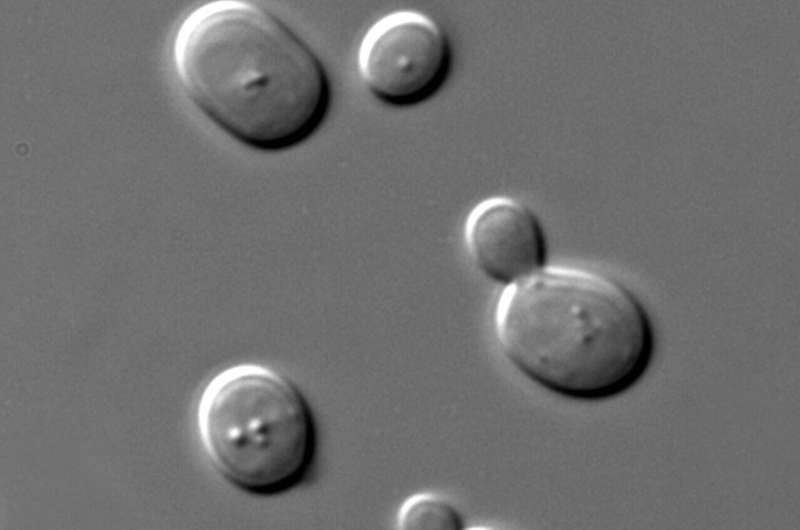This article has been reviewed according to Science X's editorial process and policies. Editors have highlighted the following attributes while ensuring the content's credibility:
fact-checked
peer-reviewed publication
trusted source
proofread
Scientists discover how yeast cells sense physical stresses on the membranes that protect them

Cell membranes play a crucial role in maintaining the integrity and functionality of cells. However, the mechanisms by which they perform these roles are not yet fully understood. Scientists from the University of Geneva (UNIGE), in collaboration with the Institut de biologie structurale de Grenoble (IBS) and the University of Fribourg (UNIFR), have used cryo-electron microscopy to observe how lipids and proteins at the plasma membrane interact and react to mechanical stress.
This work shows that, depending on conditions, small membrane regions can stabilize various lipids to trigger specific cellular responses. These discoveries, published in the journal Nature, confirm the existence of well-organized lipid domains and begin to reveal the role they play in cell survival.
Cells are surrounded by a membrane—the plasma membrane—which acts as a physical barrier but must also be malleable. These properties are endowed by the constituent components of membranes—lipids and proteins—whose molecular organization varies according to the external environment.
This dynamism is critical to membrane function but must be finely balanced to ensure that the membrane becomes neither too tense nor too floppy. How cells sense changes in the biophysical properties of the plasma membrane is thought to involve microregions on the membrane—known as microdomains—which are postulated to possess a specific lipid and protein content and organization.
High-resolution cryo-electron microscopy
The team led by Robbie Loewith, full professor in the Department of Molecular and Cellular Biology at the UNIGE Faculty of Science, is interested in how the components of the plasma membrane interact with each other to ensure that the overall biophysical properties of the membrane remain optimized for cell growth and survival.
"Until now, the techniques available did not allow us to study lipids in their natural environment inside membranes. Thanks to the Dubochet Center for Imaging (DCI) at the Universities of Geneva, Lausanne, Bern and the EPFL, we have been able to meet this challenge by using cryo-electron microscopy," explains Loewith.
This technique allows samples to be frozen at -200°C to trap membranes in their native state, which can then be observed under an electron microscope.
The scientists used baker's yeast (Saccharomyces cerevisiae), a model organism used in many research laboratories, because it is very easy to grow and genetically manipulate. What's more, most of its fundamental cellular processes mirror those of higher organisms.
This study focused on a specific membrane microdomain scaffolded by a protein coat known as eisosomes. These structures are believed to be capable of sequestering or releasing proteins and lipids to help the cells resist and/or signal damage to the membrane, using processes that were previously unknown.
"For the first time, we have succeeded in purifying and observing eisosomes containing plasma membrane lipids in their native state. This is a real step forward in our understanding of how they function," explains Markku Hakala, a post-doctoral student in the Department of Biochemistry at the UNIGE Faculty of Science and co-author of the study.
Converting a mechanical signal into a chemical signal
Using cryo-electron microscopy, the scientists observed that the lipid organization of these microdomains is altered in response to mechanical stimuli.
"We discovered that when the eisosome protein lattice is stretched, the complex arrangement of lipids in the microdomains is altered. This reorganization of the lipids likely enables the release of sequestered signaling molecules to trigger stress adaptation mechanisms. Our study reveals a molecular mechanism by which mechanical stress can be converted to biochemical signaling via protein-lipid interactions in unprecedented detail," said Jennifer Kefauver, post-doctoral researcher in the Department of Molecular and Cellular Biology and first author of the study.
This work opens many new avenues for studying the primordial role of membrane compartmentalization—i.e. the movement of proteins and lipids within membranes to form sub-compartments known as microdomains. This mechanism enables cells to perform specialized biochemical functions, in particular the activation of cellular communication pathways in response to the various stresses to which they may be exposed.
More information: Robbie Loewith, Cryo-EM architecture of a near-native stretch-sensitive membrane microdomain, Nature (2024). DOI: 10.1038/s41586-024-07720-6. www.nature.com/articles/s41586-024-07720-6
Journal information: Nature
Provided by University of Geneva



















